Measurement, Differences, and Driving Factors of Land Use Environmental Efficiency in the Context of Energy Utilization
Abstract
1. Introduction
2. Literature Review
2.1. Land Use Environmental Efficiency Measurement
2.2. Factors Affecting Land Use Environmental Efficiency
2.3. Application of Geographic Detector
3. Data Source and Research Method
3.1. Data Resource and Indicator System Construction
3.2. Descriptive Statistics
3.3. Measure the Level of Land Use Environmental Efficiency
3.4. Kernel Density Estimation
3.5. Geographical Detector Model
4. Empirical Analyses
4.1. Assessment of Land Use Environmental Efficiency Results in China
4.1.1. Subsubsection
4.1.2. Characterization of Spatial Distribution
4.2. Kernel Density Analysis
4.3. Driver Analysis
4.3.1. Risk Detector
4.3.2. Factor Detector
4.3.3. Interaction Detector
5. Discussion
5.1. Discrepancies in and Role of LUEE
5.2. Performances of Factors Influencing LUEE
5.3. Limitations
6. Conclusions and Implications
6.1. Conclusions
6.2. Policy Implications
- Enhance region-specific sustainable development strategies. The capital metropolitan area and developed coastal communities have reacted more favorably to green development policies, whereas the less developed regions in the center and west continue to experience greater environmental pressures. Therefore, it is essential to design environmental protection strategies tailored to the unique development characteristics and consumption patterns of each region, unlocking the green development potential of the western areas. Additionally, given the imbalance of land use and ecological efficiency (LUEE) in the eastern region, government efforts should prioritize rational urban land use planning, ecological restoration, and the promotion of industrial structures aligned with cleaner production. This helps transform artificial pollution transfer into a beneficial pollution halo effect.
- Balance energy consumption with economic advancement. Reducing energy consumption and achieving the goal of sustainable economic development play an important role in easing environmental pressures on land use and achieving decoupling goals in China. Since energy use is closely linked to industrial patterns and energy structures, local governments should encourage enterprises to replace highly polluting energy sources with cleaner alternatives. Policy incentives, especially financial support, should be directed towards technologically innovative industries to promote proactive energy transformation. In particular, the green transformation of the energy structure should be promoted in the western area where the land use pattern is rough and in the northeastern region where heavy industry is dominant [41].
- Develop more efficient environmental protection measures and land policies. Cities in eastern regions and metropolitan areas generally possess stronger environmental regulatory capacities. To achieve balanced green development, regional environmental protection efforts should emphasize flexibility, market mechanisms, and public participation, tailoring regulation to local conditions. Moreover, integrating industrial and commercial land use naturally with logical green space planning can link carbon sources and sinks effectively, enhancing the ecological benefits of commercial land and improving the economic value of urban properties from a planning perspective.
- Learn from international practices to optimize land governance. Comparative studies of Brazil, India, and China suggest that land efficiency depends not only on governance models but also on ecological conditions and the degree of policy integration [37]. Research on the sustainability of Transit-Oriented Development (TOD) highlights that improving the coordination between transportation and land management can effectively curb land expansion and reduce energy consumption [42]. China could further advance transit-oriented planning by integrating green ecological design principles and enhancing coordination in energy and land governance between eastern city clusters and those in the central and western regions, thereby improving LUEE.
Author Contributions
Funding
Data Availability Statement
Conflicts of Interest
Abbreviations
| LUEE | Land use environmental efficiency |
| IPCC | Intergovernmental Panel on Climate Change |
| SBM | Slacks-based measure |
| DMU | Decision-making unit |
| DEA | Data envelopment analysis |
| St. dev. | Standard deviation |
| CNY | Chinese yuan |
| CEADS | China Carbon Emission Accounts & Datasets |
| GDP | Gross domestic product |
| EPI | Global environmental performance index |
| EC | Energy consumption |
| ED | Economic development |
| IU | Industrial upgrading |
| PS | Population size |
| UE | Urban expansion |
References
- Jackson, R.B.; Ahlström, A.; Hugelius, G.; Wang, C.; Porporato, A.; Ramaswami, A.; Roy, J.; Yin, J. Human Well-being and per Capita Energy Use. Ecosphere 2022, 13, e3978. [Google Scholar] [CrossRef]
- Cao, Y.; Bian, Y. Improving the Ecological Environmental Performance to Achieve Carbon Neutrality: The Application of DPSIR-Improved Matter-Element Extension Cloud Model. J. Environ. Manag. 2021, 293, 112887. [Google Scholar] [CrossRef]
- Chen, J.; Gao, M.; Cheng, S.; Hou, W.; Song, M.; Liu, X.; Liu, Y.; Shan, Y. County-Level CO2 Emissions and Sequestration in China during 1997–2017. Sci. Data 2020, 7, 391. [Google Scholar] [CrossRef]
- Choi, Y.; Liu, Y.; Lee, H. The Economy Impacts of Korean ETS with an Emphasis on Sectoral Coverage Based on a CGE Approach. Energy Policy 2017, 109, 835–844. [Google Scholar] [CrossRef]
- Li, X.; Bei, N.; Hu, B.; Wu, J.; Pan, Y.; Wen, T.; Liu, Z.; Liu, L.; Wang, R.; Li, G. Mitigating NOX Emissions Does Not Help Alleviate Wintertime Particulate Pollution in Beijing-Tianjin-Hebei, China. Environ. Pollut. 2021, 279, 116931. [Google Scholar] [CrossRef] [PubMed]
- Zhou, P.; Ang, B.W.; Han, J.Y. Total Factor Carbon Emission Performance: A Malmquist Index Analysis. Energy Econ. 2010, 32, 194–201. [Google Scholar] [CrossRef]
- Lin, B.; Zheng, Q. Energy Efficiency Evolution of China’s Paper Industry. J. Clean. Prod. 2017, 140, 1105–1117. [Google Scholar] [CrossRef]
- Xu, G.; Schwarz, P.; Yang, H. Determining China’s CO2 Emissions Peak with a Dynamic Nonlinear Artificial Neural Network Approach and Scenario Analysis. Energy Policy 2019, 128, 752–762. [Google Scholar] [CrossRef]
- Wang, Y.; Chai, J.; Zhang, H.; Yang, B. Evaluating Construction Land Use Efficiency under Carbon Emission Constraints: A Comparative Study of China and the USA. Environ. Sci. Pollut. Res. 2022, 29, 49998–50009. [Google Scholar] [CrossRef] [PubMed]
- Yang, Q.; Pu, L.; Jiang, C.; Gong, G.; Tan, H.; Wang, X.; He, G. Unveiling the Spatial-Temporal Variation of Urban Land Use Efficiency of Yangtze River Economic Belt in China under Carbon Emission Constraints. Front. Environ. Sci. 2023, 10, 1096087. [Google Scholar] [CrossRef]
- Jiang, Y.; Zhang, Z.; Xie, G. Emission Reduction Effects of Vertical Environmental Regulation: Capacity Transfer or Energy Intensity Reduction? Evidence from a Quasi-Natural Experiment in China. J. Environ. Manag. 2022, 323, 116180. [Google Scholar] [CrossRef] [PubMed]
- Li, X.; Yang, L.; Zheng, H.; Shan, Y.; Zhang, Z.; Song, M.; Cai, B.; Guan, D. City-Level Water-Energy Nexus in Beijing-Tianjin-Hebei Region. Appl. Energy 2019, 235, 827–834. [Google Scholar] [CrossRef]
- Wei, H.; Zhang, Y. Analysis of Impact of Urbanization on Environmental Quality in China. China World Econ. 2017, 25, 85–106. Available online: https://onlinelibrary.wiley.com/doi/epdf/10.1111/cwe.12195 (accessed on 23 June 2025). [CrossRef]
- Ozcan, B.; Tzeremes, P.G.; Tzeremes, N.G. Energy Consumption, Economic Growth and Environmental Degradation in OECD Countries. Econ. Model. 2020, 84, 203–213. [Google Scholar] [CrossRef]
- Li, B.; Wang, Z.; Xu, F. Does Optimization of Industrial Structure Improve Green Efficiency of Industrial Land Use in China? Int. J. Environ. Res. Public Health 2022, 19, 9177. [Google Scholar] [CrossRef]
- Qiao, W.; Xie, Y.; Liu, J.; Huang, X. The Impacts of Urbanization on Carbon Emission Performance: New Evidence from the Yangtze River Delta Urban Agglomeration, China. Land 2024, 14, 12. [Google Scholar] [CrossRef]
- Zhang, Q.; Liu, S.; Niu, Y.; Hu, Y.; Li, L.; Cai, E.; Zhang, Y.; Zhao, M. Multi-Scenario Simulation of the Dynamic Relationship Between Land Use and Carbon Storage in the Urbanization Process: A Case Study of Zhengzhou, China. Land 2025, 14, 1227. [Google Scholar] [CrossRef]
- Liu, J.; Feng, H.; Wang, K. The Low-Carbon City Pilot Policy and Urban Land Use Efficiency: A Policy Assessment from China. Land 2022, 11, 604. [Google Scholar] [CrossRef]
- Xu, H.; Pan, X.; Guo, S.; Lu, Y. Forecasting Chinese CO2 Emission Using a Non-Linear Multi-Agent Intertemporal Optimization Model and Scenario Analysis. Energy 2021, 228, 120514. [Google Scholar] [CrossRef]
- Xia, H.; Ding, L.; Yang, S.; Wu, A. Socioeconomic Factors of Industrial Air Pollutants in Zhejiang Province, China: Decoupling and Decomposition Analysis. Environ. Sci. Pollut. Res. 2020, 27, 28247–28266. [Google Scholar] [CrossRef] [PubMed]
- Li, J.; Song, X.; Guo, Y.; Yang, Q.; Feng, K. The Determinants of China’s National and Regional Energy-Related Mercury Emission Changes. J. Environ. Manag. 2019, 246, 505–513. [Google Scholar] [CrossRef]
- Wang, J.; Zhang, X.; Yang, F.; Zhou, Q. Explore the Influence Mechanism of Carbon Emissions Decline on Energy Intensity with Two-Layer Factor Decomposition Method in Beijing-Tianjin-Hebei Region. Environ. Sci. Pollut. Res. 2019, 26, 4041–4055. [Google Scholar] [CrossRef] [PubMed]
- Li, T.; Wang, X.; Jia, H. Evaluate Water Yield and Soil Conservation and Their Environmental Gradient Effects in Fujian Province in South China Based on InVEST and Geodetector Models. Water 2025, 17, 230. [Google Scholar] [CrossRef]
- Zhou, Y.; Chen, T.; Wang, J.; Xu, X. Analyzing the Factors Driving the Changes of Ecosystem Service Value in the Liangzi Lake Basin—A GeoDetector-Based Application. Sustainability 2023, 15, 15763. [Google Scholar] [CrossRef]
- Gan, L.; Halik, Ü.; Shi, L.; Ru, J.; Wei, Z.; Li, J.; Welp, M. Integrating Multi-Source Data to Explore Spatiotemporal Dynamics and Future Scenarios of Arid Urban Agglomerations: A Geodetector–PLUS Modelling Framework for Sustainable Land Use Planning. Remote Sens. 2025, 17, 1851. [Google Scholar] [CrossRef]
- Zhang, S.; Zhou, Y.; Yu, Y.; Li, F.; Zhang, R.; Li, W. Using the Geodetector Method to Characterize the Spatiotemporal Dynamics of Vegetation and Its Interaction with Environmental Factors in the Qinba Mountains, China. Remote Sens. 2022, 14, 5794. [Google Scholar] [CrossRef]
- Lei, K.; Li, Y.; Zhang, Y.; Wang, S.; Yu, E.; Li, F.; Xiao, F.; Shi, Z.; Xia, F. Machine Learning Combined with Geodetector Quantifies the Synergistic Effect of Environmental Factors on Soil Heavy Metal Pollution. Environ. Sci. Pollut. Res. 2023, 30, 126148–126164. [Google Scholar] [CrossRef] [PubMed]
- Shi, S.; Peng, S.; Lin, Z.; Huang, B.; Ma, D.; Zhu, Z.; Zhu, Y.; Zhang, R.; Li, T. Analysis of the Spatial Pattern and Causes of Ecological Environmental Quality in Myanmar Based on the RSEI Model and the Geodetector-GCCM Method. Front. Environ. Sci. 2025, 13, 1514008. [Google Scholar] [CrossRef]
- Liang, L.; Wang, Z.; Li, J. The Effect of Urbanization on Environmental Pollution in Rapidly Developing Urban Agglomerations. J. Clean. Prod. 2019, 237, 117649. [Google Scholar] [CrossRef]
- Zhang, K.; Xu, D.; Li, S. The Impact of Environmental Regulation on Environmental Pollution in China: An Empirical Study Based on the Synergistic Effect of Industrial Agglomeration. Environ. Sci. Pollut. Res. 2019, 26, 25775–25788. [Google Scholar] [CrossRef]
- Shan, Y.; Huang, Q.; Guan, D.; Hubacek, K. China CO2 Emission Accounts 2016–2017. Sci. Data 2020, 7, 54. [Google Scholar] [CrossRef]
- Kuang, B.; Lu, X.; Zhou, M.; Chen, D. Provincial Cultivated Land Use Efficiency in China: Empirical Analysis Based on the SBM-DEA Model with Carbon Emissions Considered. Technol. Forecast. Soc. Change 2020, 151, 119874. [Google Scholar] [CrossRef]
- Xu, J.; Dong, Y.; Xie, L.; Chen, S. The Pollution Haven Strikes Back?—Evidence from Air Quality Daily Variation in the Jing-Jin-Ji Region of China. Environ. Sci. Policy 2022, 138, 105–121. [Google Scholar] [CrossRef]
- Huang, P.; Westman, L. China’s Imaginary of Ecological Civilization: A Resonance between the State-Led Discourse and Sociocultural Dynamics. Energy Res. Soc. Sci. 2021, 81, 102253. [Google Scholar] [CrossRef]
- Yi, L.; Bai, N.; Yang, L.; Li, Z.; Wang, F. Evaluation on the Effectiveness of China’s Pilot Carbon Market Policy. J. Clean. Prod. 2020, 246, 119039. [Google Scholar] [CrossRef]
- Lin, W.; Huang, J. Impacts of Agricultural Incentive Policies on Land Rental Prices: New Evidence from China. Food Policy 2021, 104, 102125. [Google Scholar] [CrossRef]
- Zeng, C.; Deng, X.; Dong, J.; Hu, P. Urbanization and Sustainability: Comparison of the Processes in “BIC” Countries. Sustainability 2016, 8, 400. [Google Scholar] [CrossRef]
- Ma, L. Inter-Provincial Power Transmission and Its Embodied Carbon Flow in China: Uneven Green Energy Transition Road to East and West. Energies 2021, 15, 176. [Google Scholar] [CrossRef]
- Qian, Y.; Cao, H.; Huang, S. Decoupling and Decomposition Analysis of Industrial Sulfur Dioxide Emissions from the Industrial Economy in 30 Chinese Provinces. J. Environ. Manag. 2020, 260, 110142. [Google Scholar] [CrossRef]
- Meng, S.; Siriwardana, M.; McNeill, J.; Nelson, T. The Impact of an ETS on the Australian Energy Sector: An Integrated CGE and Electricity Modelling Approach. Energy Econ. 2018, 69, 213–224. [Google Scholar] [CrossRef]
- Zeng, X.; Xiang, H.; Xue, Y.; Su, Y.; Tong, Y.; Mao, Z. A Scenario-Based Optimization Frame to Adjust Current Strategy for Population- Economy-Resource-Environment Harmony in an Urban Agglomeration, China. Sustain. Cities Soc. 2021, 67, 102710. [Google Scholar] [CrossRef]
- Yang, W.; Xu, Q.; Yi, S.; Shankar, R.; Chen, T. Enhancing Transit-Oriented Development Sustainability through the Integrated Node-Place-Ecology (NPE) Model. Transp. Res. Part D Transp. Environ. 2024, 136, 104456. [Google Scholar] [CrossRef]
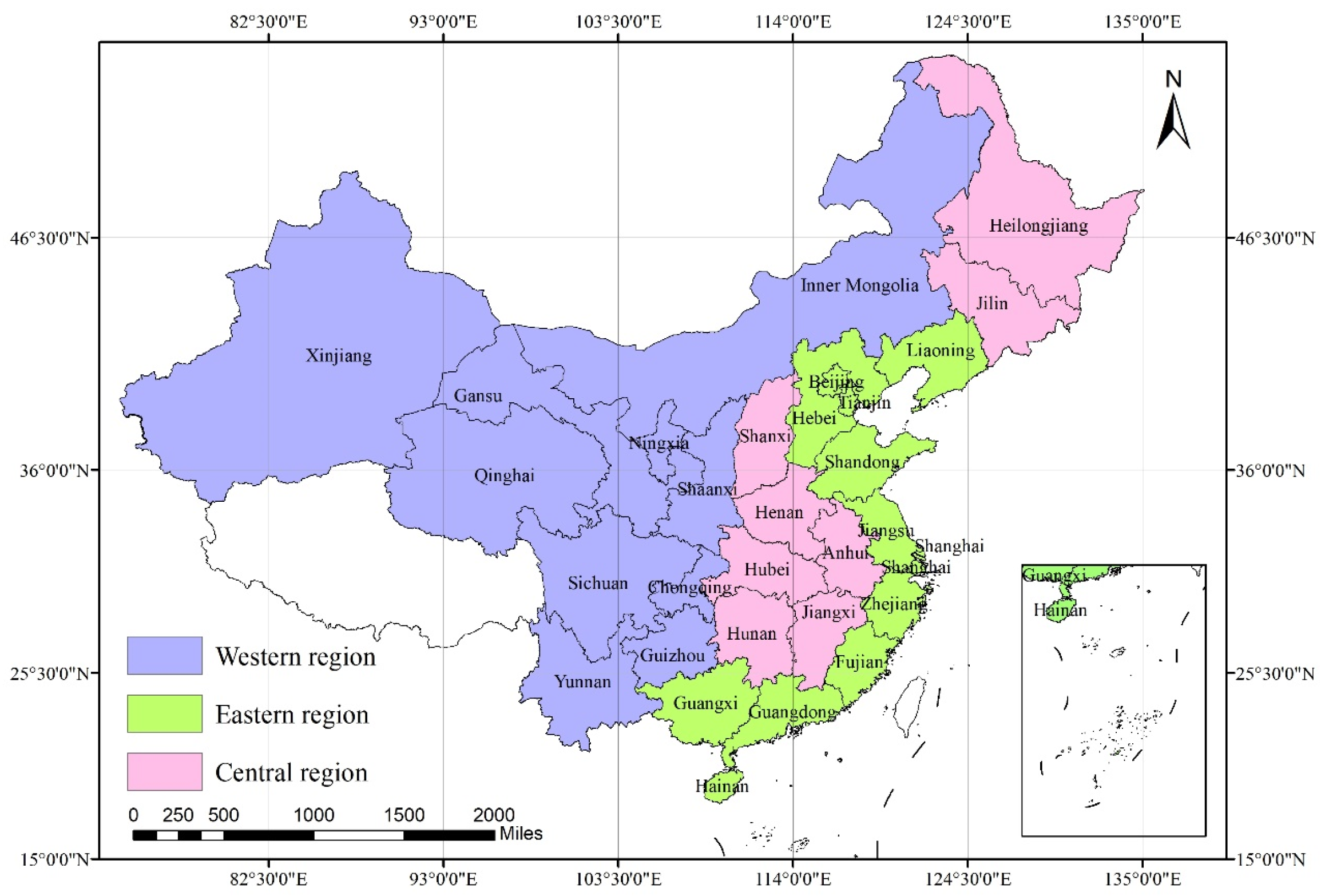
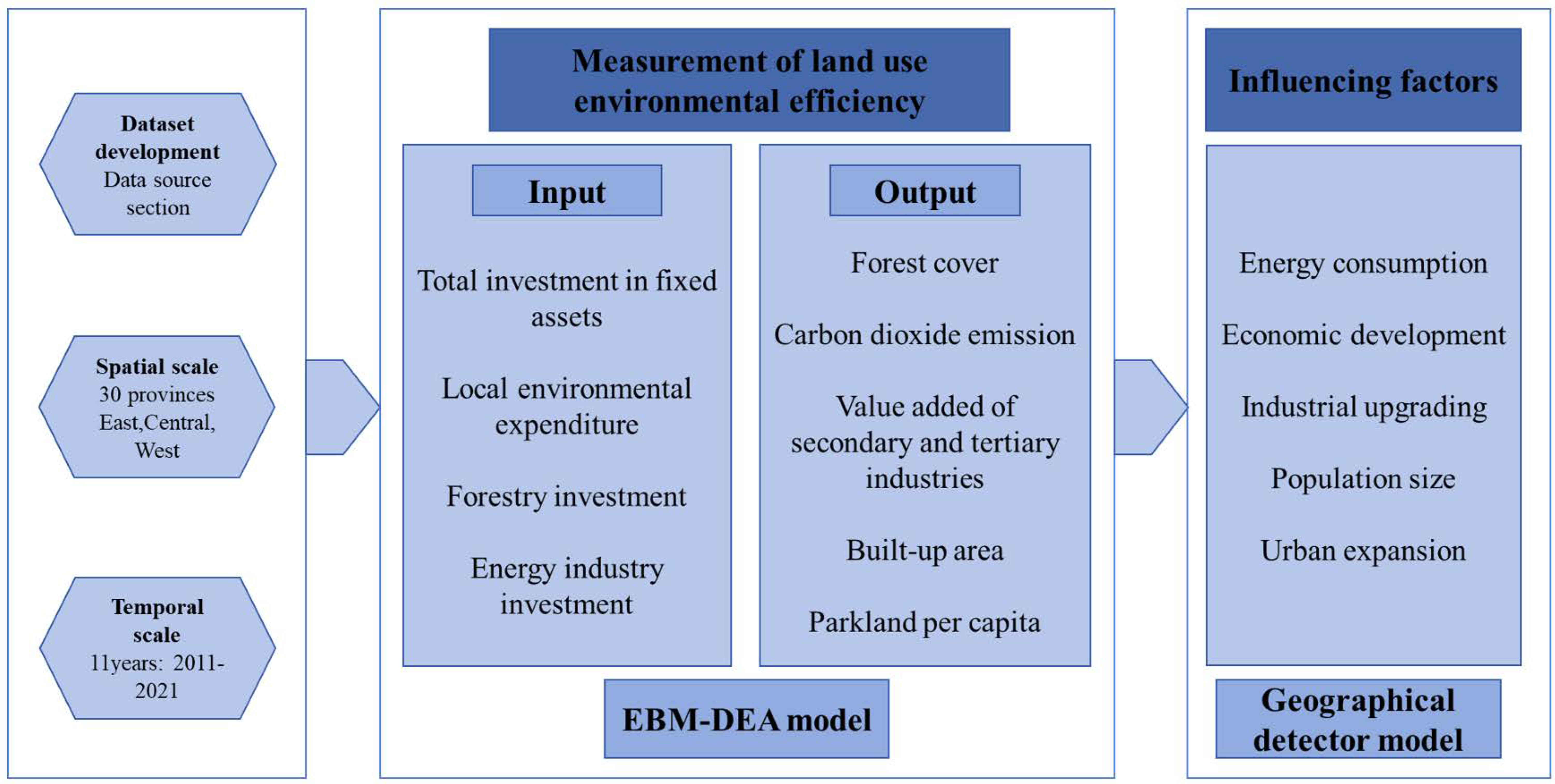

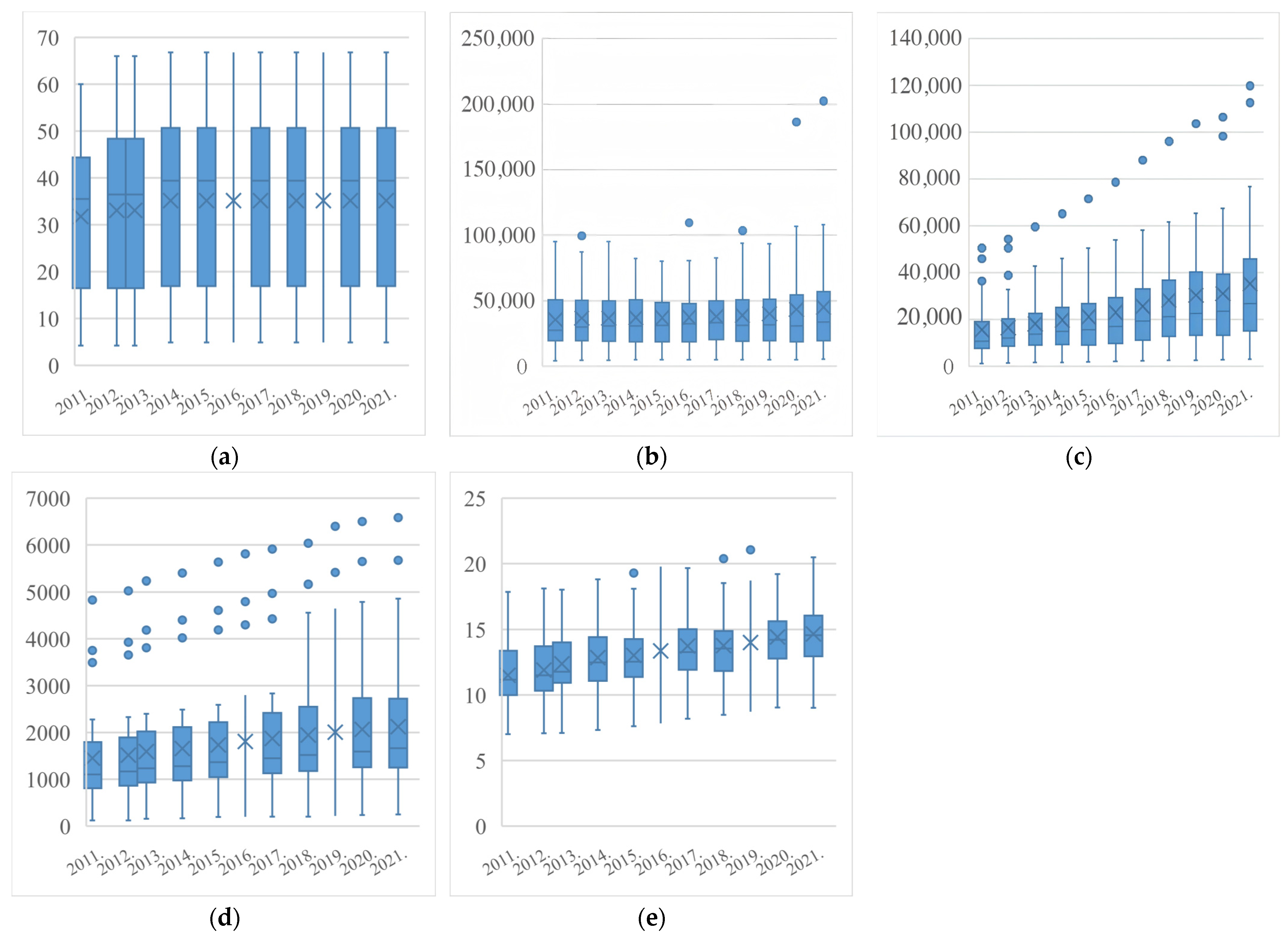
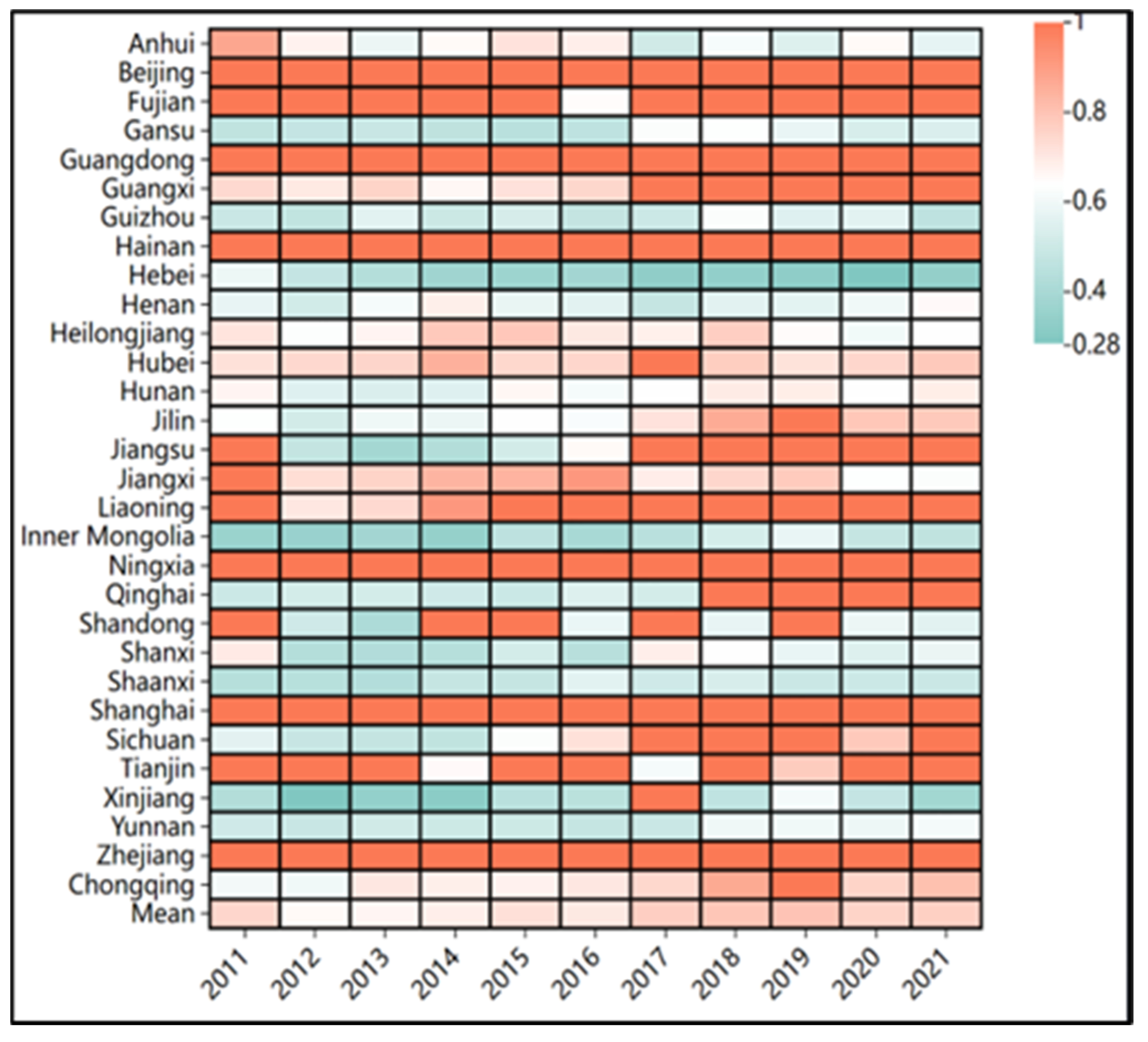
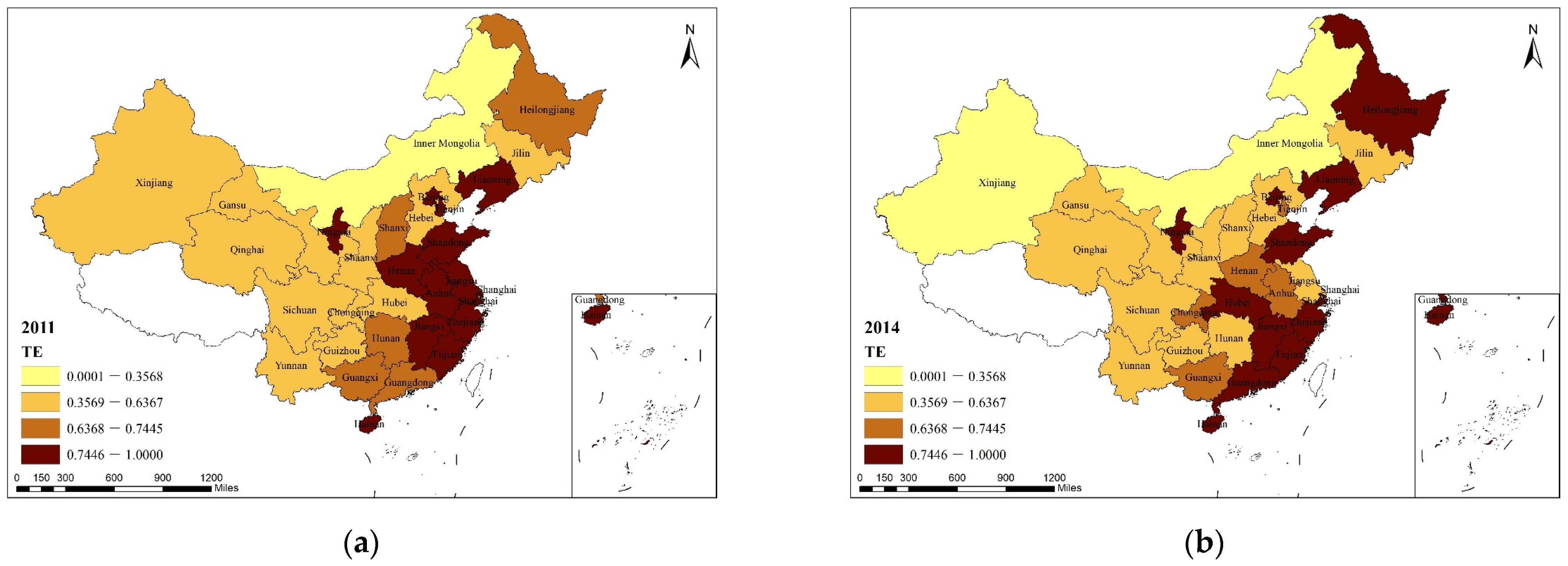
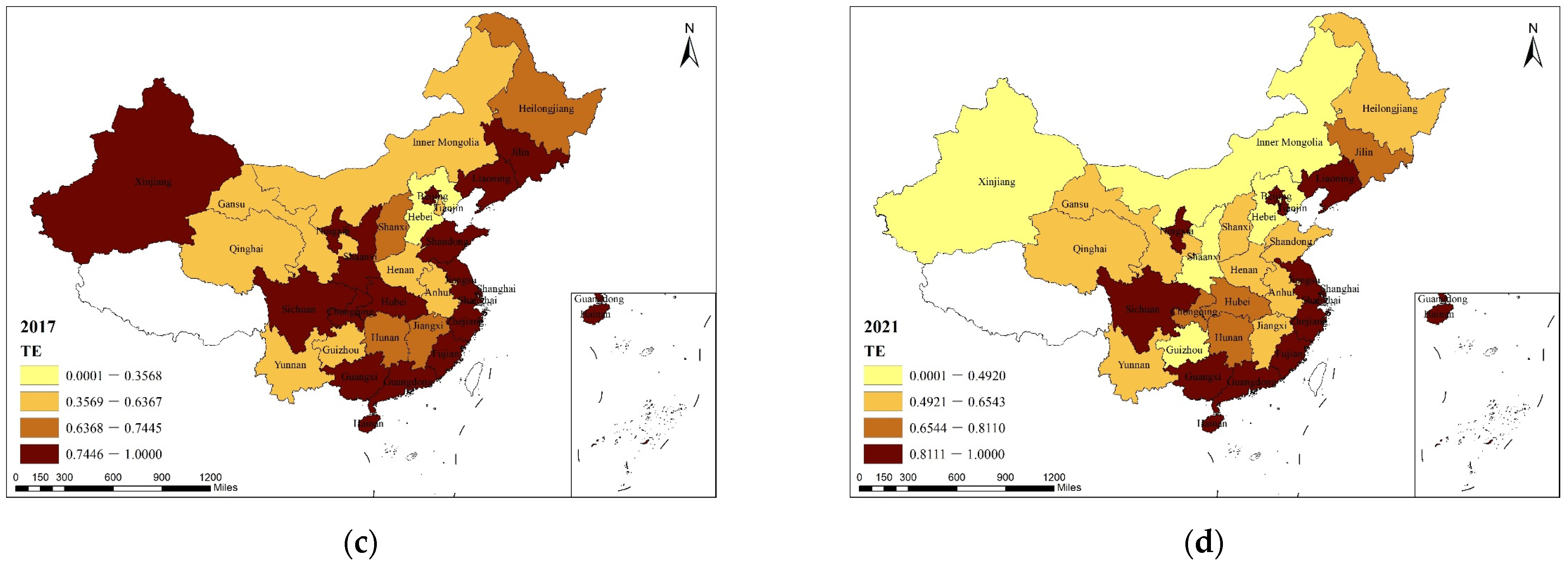
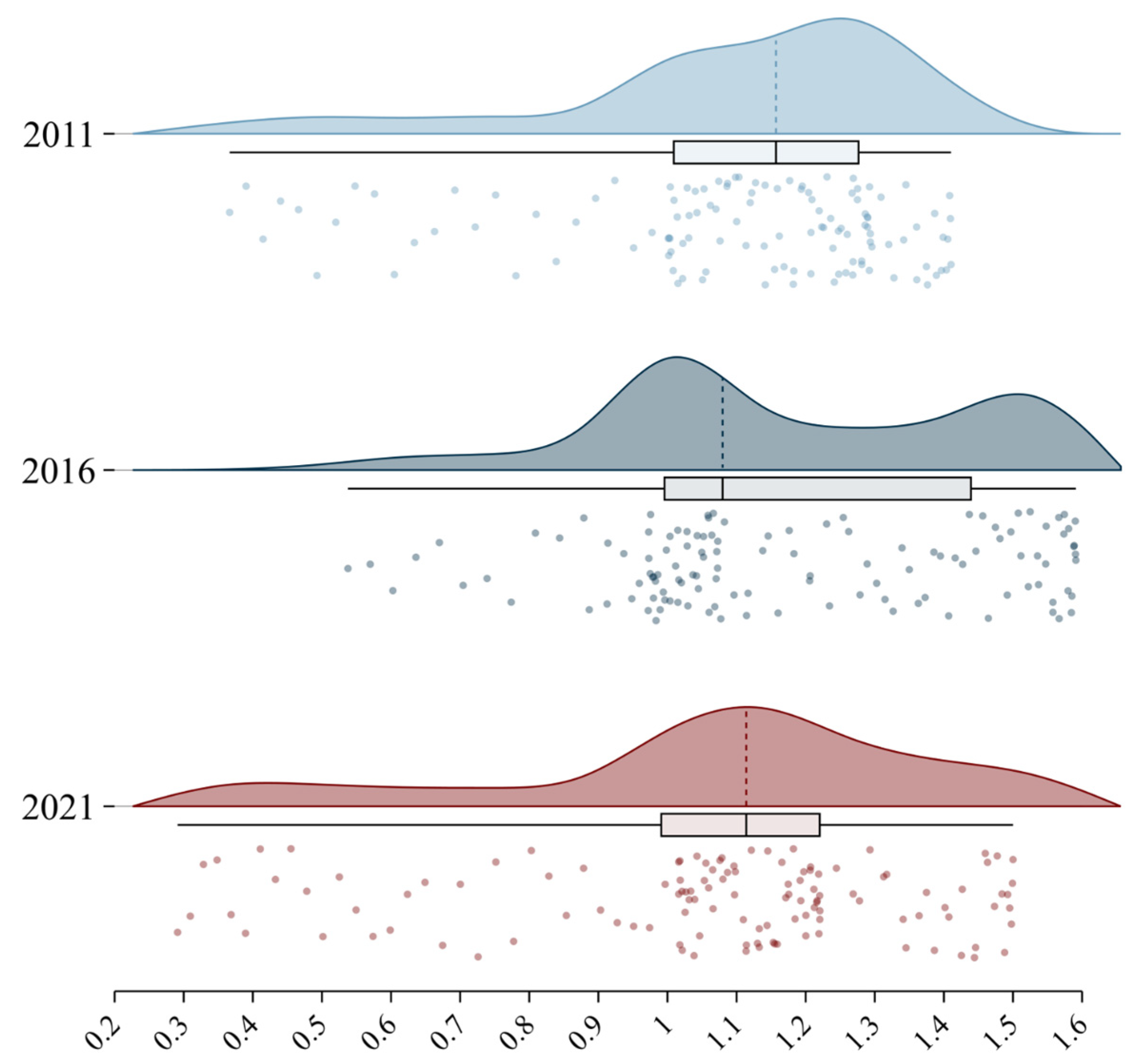

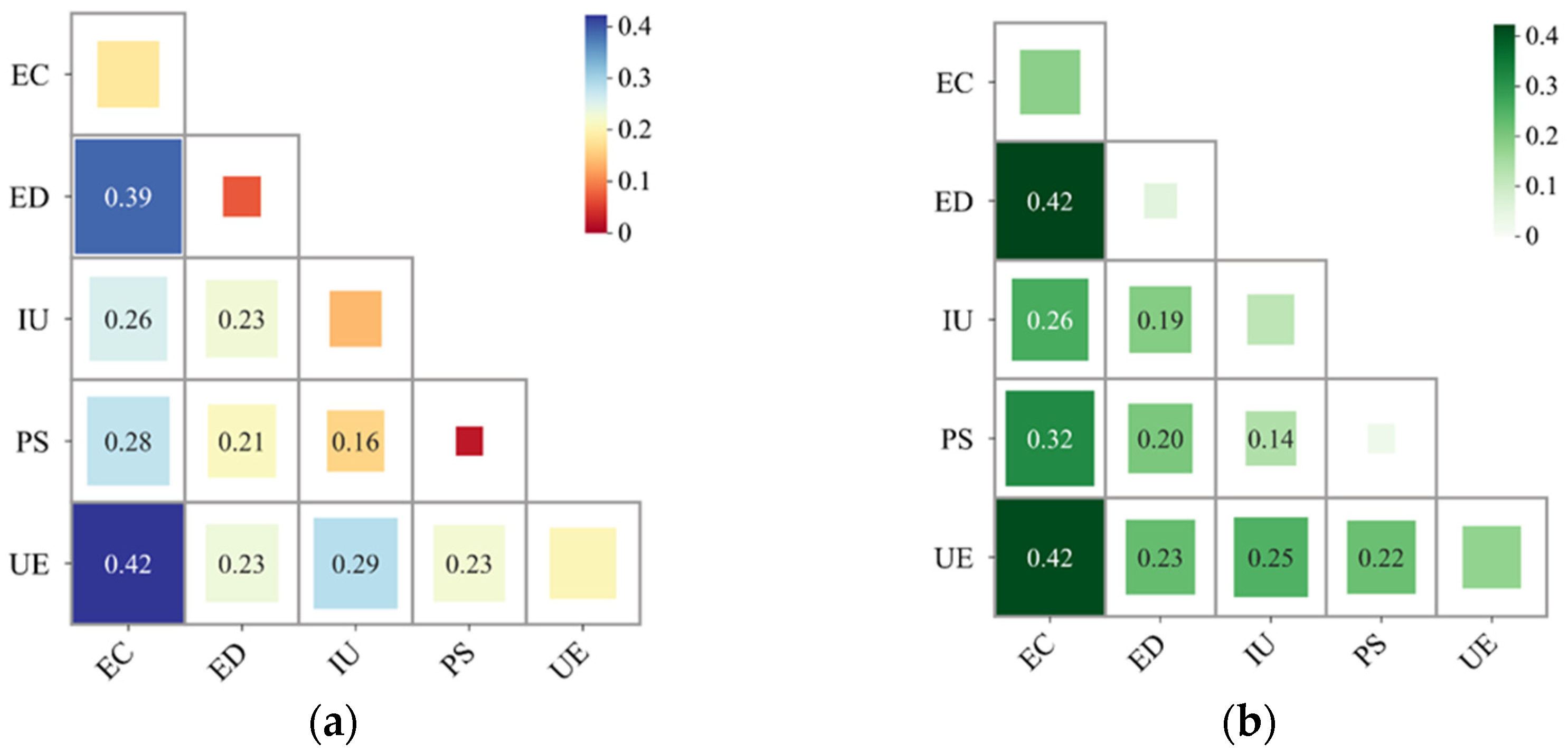
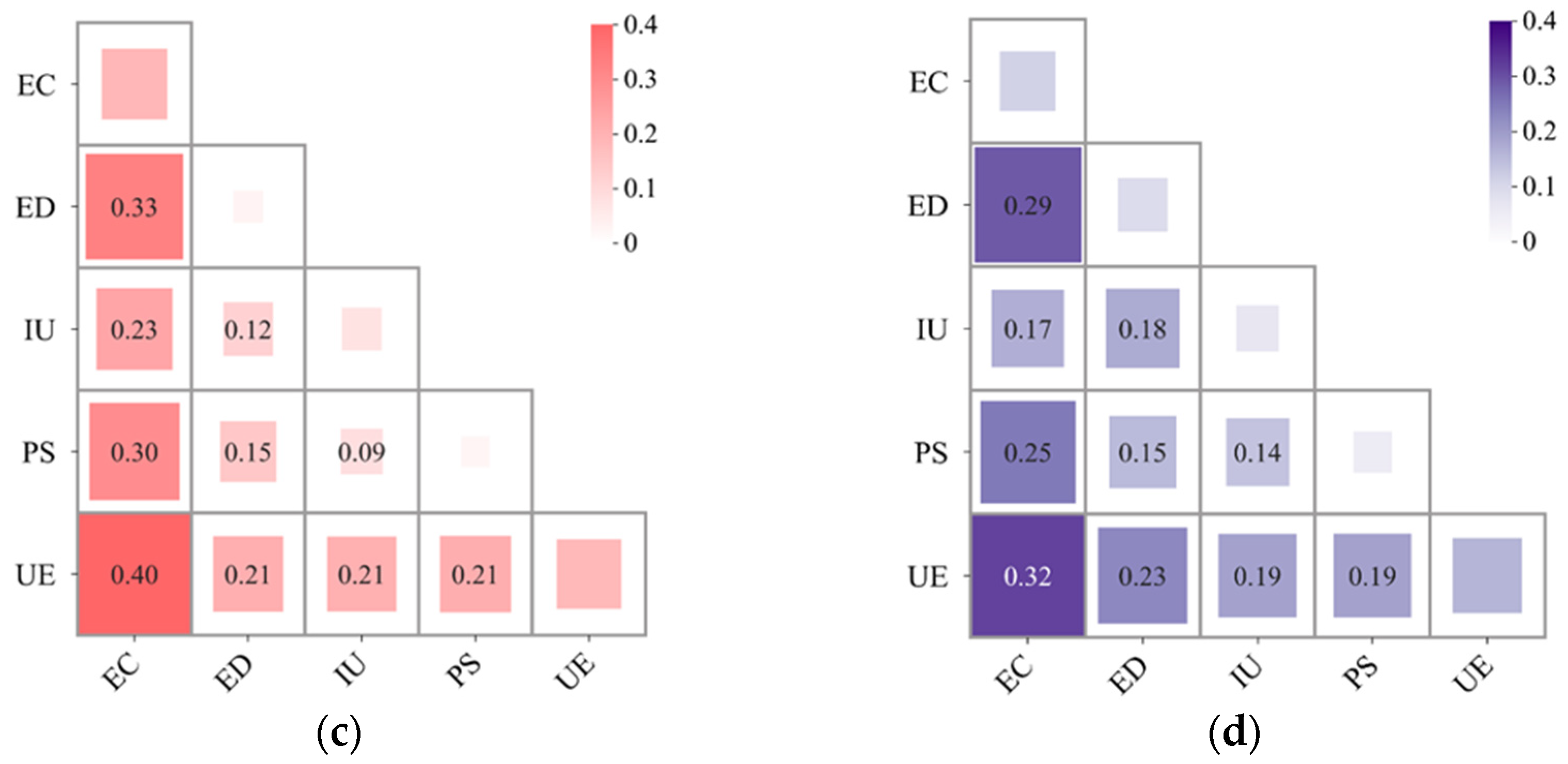
| Variable Attribute | Variables | Unit | Meaning |
|---|---|---|---|
| Input | Total investment in fixed assets | CNY 108 | The monetary value associated with the workload of fixed asset building and acquisition activities |
| Local environmental expenditure | CNY 108 | The expenditure of funds for environmental protection activities of local governments | |
| Forestry investment | CNY 108 | Activities that put factors into forestry production | |
| Energy industry investment | CNY 108 | The activity of investing elements into energy production | |
| Forest cover | % | Forest area/total land area | |
| Undesirable output | Carbon dioxide emission | CNY 104 | Carbon dioxide emissions |
| Desirable output | Value added of secondary and tertiary industries | CNY 108 | The total value added of the tertiary and secondary industries |
| Desirable output | Built-up area | Square kilometers | Actual developed and built-up area within the city’s administrative district, reflecting the degree of urbanization |
| Desirable output | Parkland per capita | Square meters/person | The amount of parkland per capita occupied by urban residents, reflecting their enjoyment of green space |
| Energy Consumption | Economic Development | Industrial Upgrading | Population Size | Urban Expansion | ||
|---|---|---|---|---|---|---|
| Whole nation | q statistic | 0.182 | 0.070 | 0.137 | 0.021 | 0.204 |
| p value | 0.000 | 0.047 | 0.013 | 0.044 | 0.000 | |
| Eastern region | q statistic | 0.183 | 0.052 | 0.119 | 0.025 | 0.175 |
| p value | 0.000 | 0.106 | 0.018 | 0.197 | 0.000 | |
| Central region | q statistic | 0.190 | 0.031 | 0.074 | 0.026 | 0.185 |
| p value | 0.000 | 0.081 | 0.203 | 0.011 | 0.010 | |
| Western region | q statistic | 0.113 | 0.092 | 0.068 | 0.053 | 0.161 |
| p value | 0.000 | 0.045 | 0.162 | 0.039 | 0.013 |
Disclaimer/Publisher’s Note: The statements, opinions and data contained in all publications are solely those of the individual author(s) and contributor(s) and not of MDPI and/or the editor(s). MDPI and/or the editor(s) disclaim responsibility for any injury to people or property resulting from any ideas, methods, instructions or products referred to in the content. |
© 2025 by the authors. Licensee MDPI, Basel, Switzerland. This article is an open access article distributed under the terms and conditions of the Creative Commons Attribution (CC BY) license (https://creativecommons.org/licenses/by/4.0/).
Share and Cite
Wang, L.; Liu, H.; Liu, X.; Ren, F. Measurement, Differences, and Driving Factors of Land Use Environmental Efficiency in the Context of Energy Utilization. Land 2025, 14, 1573. https://doi.org/10.3390/land14081573
Wang L, Liu H, Liu X, Ren F. Measurement, Differences, and Driving Factors of Land Use Environmental Efficiency in the Context of Energy Utilization. Land. 2025; 14(8):1573. https://doi.org/10.3390/land14081573
Chicago/Turabian StyleWang, Lingyao, Huilin Liu, Xiaoyan Liu, and Fangrong Ren. 2025. "Measurement, Differences, and Driving Factors of Land Use Environmental Efficiency in the Context of Energy Utilization" Land 14, no. 8: 1573. https://doi.org/10.3390/land14081573
APA StyleWang, L., Liu, H., Liu, X., & Ren, F. (2025). Measurement, Differences, and Driving Factors of Land Use Environmental Efficiency in the Context of Energy Utilization. Land, 14(8), 1573. https://doi.org/10.3390/land14081573






